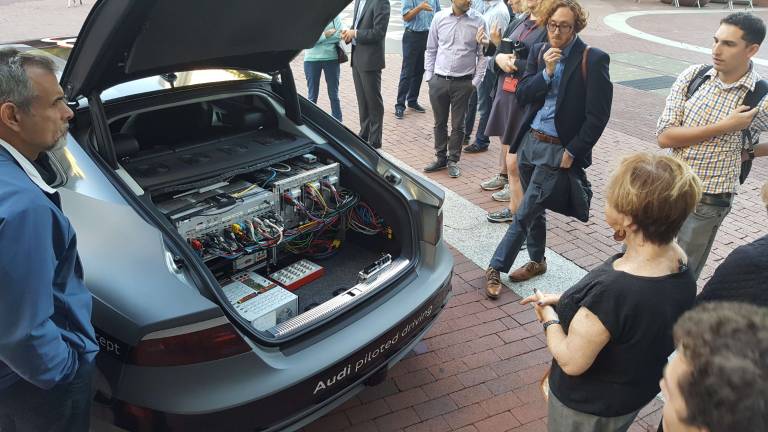AUTONOMOUS: SELF-DRIVING CARS ON THE WAY

Self-driving vehicles will roam New York City's streets within a few decades, marking the beginning of a sea change that will require major modifications to the city's infrastructure, according to transportation experts who addressed a forum on the topic earlier this week.
The technology has advanced rapidly during the last decade, so much so that one panelist projected that autonomous vehicles would be ubiquitous across the U.S. in 30 years. Although the shift is expected to happen in stages, with farm vehicles and freight trucks being the first expected to use the technology, the consensus is that public transportation would be close behind.
But self-driving doesn't mean driverless. In the models being developed by Tesla, Audi and Google, control is transferred between the driver and the vehicle depending on surroundings and other factors, such as road conditions. When a vehicle leaves a highway, for example, the driver can take over to navigate residential streets and traffic.
“It's essential to get the consumers and drivers to understand what the technology is, and not be afraid of it and misuse it,” said Brad Stertz, the director of government affairs for Audi.
The last thing his company wants, he added, “is for people to think, 'I can now jump in the back seat and take a nap or have a coffee or something.'”
Roughly 45 people attended the forum, which was hosted by Manhattan Borough President Gale Brewer Wednesday at the David N. Dinkins Municipal Building.
“Self-driving vehicles are quickly transitioning from science-fiction to reality, so we need to think about how they will change the world we live in,” Brewer said before the forum. “Where this technology is, where it's going, and the risks and rewards of integrating it into cities like ours are questions we need to wrestle with now, because these vehicles will be on our streets much sooner than you think.”
While the technology's assimilation into city streetscapes will be incremental, the speakers agreed that planning for it should start early, including for a host of new regulations.
Vehicles would have 360-degree awareness and would communicate with other vehicles and a network built into the city's infrastructure, such as sensors in traffic signals. They would also require well-maintained street markings and asphalt conditions for vehicles to navigate safely.
Regardless, prospects are promising, said Will Carry, senior director for special projects at the city's Department of Transportation. More predictable and uniform traffic flow could reduce gridlock, while less driver distraction and speeding could mean safer streets for pedestrians. People with disabilities could gain greater mobility. With the rapid growth of the electric car industry — Audi expects 25 percent of its new vehicles to be electric by 2025, Stertz said — autonomous and electric infrastructure could be designed to work together, with self-driving taxis driving themselves to charging stations when their batteries get low.
Carry said that the conversation about regulation of autonomous vehicles at the federal level doesn't currently consider cities, but should. Jeff Garber, director of technology and innovation at the New York City Taxi and Limousine Commission, said that consumer protections, vehicle safety standards and accessibility for all New Yorkers will be essential to a system that is truly beneficial to the city.
“In the best case scenario, all the positives of autonomous vehicles will show up on their own, but they won't necessarily do it without some regulation to nudge them in the right direction,” Garber said.
Joanna Oltman Smith, 46, a Park Slope resident and a member of Community Board 6 in Brooklyn and an advocate for safe streets, suggested that the city had miles to go before New York could safely accommodate the self-driving vehicles.
“What I had not thought about is this need for the infrastructure to be in impeccable condition to maintain safety for our street users,” she said, “and all you have to do is step outside and see the conditions of our road markings on the city level, and they're not up to the right level that they're going to need to be to support this kind of vehicle.”